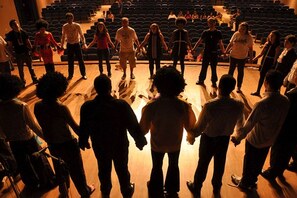English materials for
Secondary school in México
Secondary school in México
Second Grade
Unit 2
Lesson plan
Lesson plan | Videos | Worksheets & Handouts
Exercises for students | Project Ideas | Pop Quizzes & Exams
Exercises for students | Project Ideas | Pop Quizzes & Exams
|
Introduction (10 mins.) T writes a few discussion points on the board:
T asks Ss to talk about their favorite play, scene or writer. Development (15 mins.) Ss classify a list of vocabulary into the following categories: famous plays, people, places, equipment and parts of the story. Consolidation (20 mins.) T asks Ss what different kinds of entertainment are put on at the theater and the intended audience. Then, T writes on the board the types of entertainment: plays, musicals, opera, ballet, and pantomime. Next, T reads aloud the characteristics of each type and encourages Ss to guess which type is.
Ss illustrate each type of entertainment on their notebooks. Closure (5 mins.) Then, T reads aloud to the class the achievements for this unit and encourages Ss to share their ideas about the meaning of each achievement. Ss say their expectations they have of the unit. Time filler: "Vocabulary of theater plays" - Complete a crossword with vocabulary related to theater plays. Homework: Bring information about theater plays: the name of the play, actors, actresses, genres, elements in a theater, and photos. Introduction (10 mins.) T introduces theatrical genres by showing Ss 4 images. T encourages Ss to classify the images into which ones make them cry or make them laugh. Ss explain their feelings. Then, T label each image with theatrical genres (comedy, melodrama, horror, and romance). Development (25 mins.) Ss match the genres with their descriptions. T asks Ss to classify characteristics of each genre (comedy, horror, musical, romance). Here are some characteristics:
Ss read synopsis of famous plays and identify the genres. T asks Ss to read aloud 4 excerpts from play scenes and they have to identify the genre of each excerpt. Closure (5 mins.) Ss summarize the characteristics of each genre that they saw. |
|
|
Introduction (5 mins.) T asks Ss about their favorite play. Ss answer the following questions:
T hands out jumbled texts of a play script, and Ss to put them in order. T invites Ss to discuss what information is in the play script. T explains to Ss the main parts of the play script (Title, author/playwright, characters, cast, setting, stage directions, dialogues).
T asks Ss to label the parts of a play script. Closure (10 mins.) T writes true/false statements of key points from the session and asks Ss to raise their thumbs (for true) or down (for false) for each one:
Introduction (5 mins.) In pairs, T handouts a worksheet for each S and asks them to label emotions. Development (25 mins.) T reads aloud a list of descriptions of emotions and encourages Ss to guess which emotion is.
Consolidation (15 mins.) Ss watch a clip (short scene) of a play and encourages Ss to match key events with emotions. For example: Play: Romeo and Juliet Key events:
Ss have a class discussion about how important feelings and emotions are during play scenes. |
|

